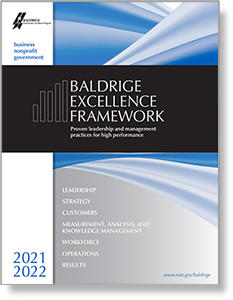Blogrige
The Official Baldrige Blog
Do You Have an Organizational Purpose? Is It Mere Propaganda?

In a recent blog about CEO challenges and opportunities in 2022, the first opportunity listed was the opportunity to “make a difference.” As stated in that blog, “Employees, customers, and investors want to associate with organizations that serve a larger purpose (emphasis added) than may be expressed in their mission statement. They want to be associated with organizations that live their values and have a commitment to societal responsibilities, environmental stewardship, and equity and inclusivity.”
In 2019, The Business Roundtable (BRT) issued a “Statement on the Purpose of a Corporation signed by 181 CEOs who commit to lead their companies for the benefit of all stakeholders–customers, employees, suppliers, communities and shareholders.” It thus redefined the purpose of a corporation as participating in stakeholder capitalism, putting the interests of employees, customers, suppliers, and communities on par with shareholders.
There was some subsequent criticism of the degree of follow-through on this commitment by some members of the BRT. In 2022, this commitment is taking on significant importance with a growing number of organizations in the BRT and beyond.
To show a commitment to a larger purpose, many organizations are now developing statements of purpose that accompany their mission, vision, and values. As with mission, vision, and values, purpose is meaningless unless translated into action. As with mission, vision, and values, purpose is detrimental to the engagement and loyalty of stakeholders, unless the purpose is incorporated into organizational strategy, goals, and metrics.
Incorporating Purpose
The topic of incorporating purpose into strategy (and action) was addressed by Graham Kenny in the May/June 2022 issue of Harvard Business Review. As reported in other studies, he points out that companies with a clear purpose and deployment of that purpose through actions do better than those without such a commitment. As an example, he discusses Woolworths, Australia’s largest supermarket chain. In 2017, Woolworths provided two very different statements of its corporate purpose. One spoke to “adding quality of life” for its customers and people. The other stated, ”We are focused on shareholder returns through the effective deployment of capital and ensuring we deliver on our Group targets.” Today, Woolworths' stated purpose no longer mentions shareholders; it is “to create better experiences together for a better tomorrow.” This statement is a guide for Woolworths’ strategic planning, and the business now has a broad range of related metrics across its stakeholder groups of shareholders, customers, suppliers, employees, and the community.
At the Consumer Goods Forum in Dublin in June 2022, the consumer products division chief of L’Oreal reported on its sustainability goals, which are set out to 2030. As of today, 70% of the PET plastic that the division uses worldwide is recycled and 25 of its 44 manufacturing plants are carbon neutral. By 2030, the company intends to use recycled and reused water for all its industrial processes.
Baldrige Excellence Framework and Purpose
Societal contributions is one of the Baldrige core values. The Baldrige Excellence Framework® booklet description of the core value states,
“Considering societal well-being and benefit means leading and supporting…the environmental, social, and economic systems in your organization’s sphere of influence.”
- Item 1.2 of the Baldrige Criteria for Performance Excellence® (PDF) is entitled "Governance and Societal Responsibilities." It asks how societal well-being and benefit are incorporated into your strategy and daily operations.
- Item 2.1, "Strategy Development," asks how changes in your external environment are considered in your strategic planning.
- Item 5.2, "Workforce Engagement," specifically asks about workforce equity and inclusion for a diverse workforce. The Criteria also ask about how you track progress on achieving strategic plan objectives and the results for achieving those objectives.
Given the changing stakeholder demands and the greater commitment to more inclusive purposes, future revisions of the Baldrige Excellence Framework® might provide greater emphasis on societal well-being as part of remaining at the leading edge of validated leadership and performance practice.
Is a Purpose Statement Necessary?
I believe a purpose statement can provide great focus and be a powerful engagement vehicle for an organization’s stakeholders. That said, I think commitment to “making a difference” is what really matters. Instead of, or in addition to, a purpose statement an organization could include its purpose in its vision statement or make it a strategic pillar with associated strategic objectives, action plans, and metrics.
Real companies are doing real good! Each organization must craft its own path to its purpose and that purpose’s deployment through strategy, goals, and metrics. The value comes in what your organization actually does. So please consider your purpose today!

Baldrige Excellence Framework®
The Baldrige Excellence Framework has empowered organizations to accomplish their missions, improve results, and become more competitive. It includes the Criteria for Performance Excellence, core values and concepts, and guidelines for evaluating your processes and results.
Purchase your copy today!
Available versions: Business/Nonprofit, Education, and Health Care
About the author
Related Posts
Comments
Barry,
Thanks for the comment. As mentioned in the blog, some members of the BRT were criticized for their actual commitment to their greater purpose. I also pointed out that a purpose statement is of little value without accompanying strategic objectives, action plans, and metrics. I did not remind blog readers that in addition to Criteria items 1.2, 2.1 and 5.2, a critical element of executing on an organization's stated purpose is 7.4a.(5) which asks for the results of your actions "to make a difference" in your communities.
Thanks for allowing me to add emphasis to your comments about results!
Harry






Is a statement of purpose propaganda? It is easy to sort who has a commitment to a stated purpose from the masses who have an fugazzi statement of purpose.
One of the Baldrige tests for excellence is asking, "What measures do you use to evaluate and improve your commitment to your purpose statement?"
What the other brainiac Harry, (Mikel Harry of Six Sigma fame) said comes in handy here.
"You do not measure what you do not value."
"You do not value what you do not measure."
"You cannot do what you do not know."
"You will not know what to do until you measure."
So I ask, how does MBNQA measure its commitment to ensuring that its recipients have a genuine commitment its stated purpose?